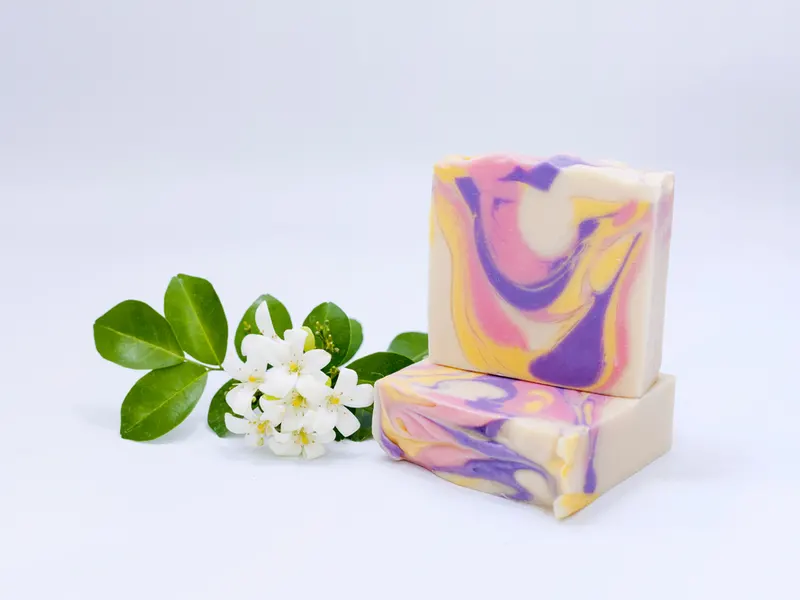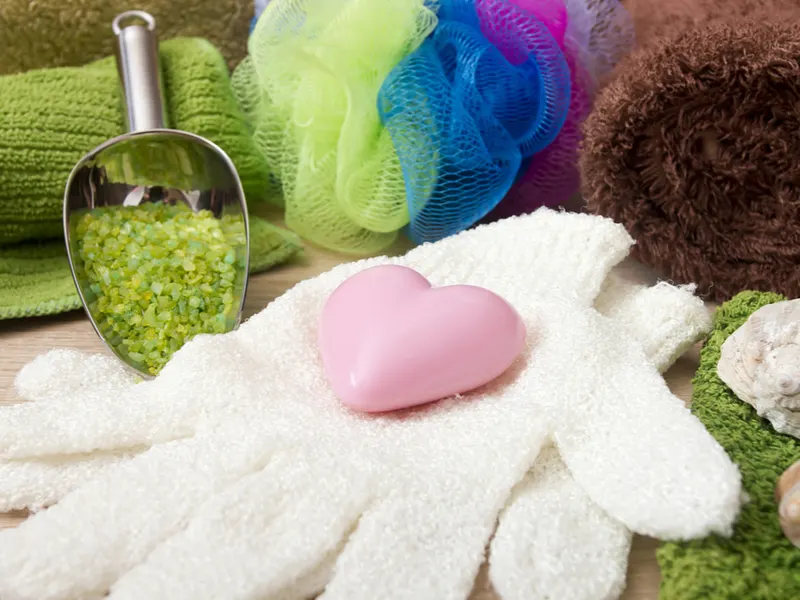Jump to:
If you want to make shampoo at home, it is a simple and effective way to save money on your beauty routine and create personalized blends that work for your specific hair. If you’ve ever wondered how to make shampoo, this straightforward step-by-step guide will show you how.
How to Make Shampoo: A Summary

Dot69/Shutterstock
Making your own homemade shampoo can save you lots of money in the long run and help your hair look and feel its best. Once you get comfortable with making your own shampoo, you’ll be able to customize it with different scents and moisturizers.
- Be Aware of Your Scalp Needs
- Consider Unconventional Ingredients
- Choose Your Essential Oils Carefully
- Understand the Power of Naturally Clarifying Ingredients
- Don’t Be Afraid to Customize
- Tone Colored Hair Naturally
- Store Your Shampoo Properly
- Consider Creating Your Own Conditioner
You’ll never be caught without shampoo again by following these easy steps, and you’ll know what you’re putting in your hair.
How to Make Shampoo in 8 Easy Steps
Making your own shampoo is easier than ever. Simply follow these eight steps, and you will be well on your way to having a great, homemade base shampoo for which you can create several different variations.
Although you can get natural shampoos at beauty stores and some higher-end drug stores, it’s easy to make natural shampoo right at home. You can even check out the ingredients list of some of the more popular natural shampoos to see what you can add to yours.
1. Be Aware of Your Scalp Needs
Everyone’s scalp is different, so understanding your specific scalp needs is the first step to making a great shampoo. Although you don’t need to be a scientist to understand what’s going on on your scalp entirely, it does help to have a basic idea about pH balance.
If you don’t have the proper pH balance in your shampoo, your scalp could become irritated. If you have sensitive skin, make sure that your homemade shampoo isn’t too acidic because it could irritate or even hurt your skin.
Stop using any homemade or store-bought products if you start to see signs of irritation like eczema or psoriasis or if you’re noticing pain or hair loss.
If you see any open wounds or cuts, stop using your homemade shampoo immediately and see a doctor. On the other hand, people with skin concerns or sensitivities, like eczema, might benefit from using homemade shampoo rather than store-bought varieties.
This is because they are less likely to irritate the skin over time. If you dye your hair or have damaged locks, homemade shampoo can help you get your hair’s luster back too.
Your scalp needs to dictate what types of ingredients you’ll use in the shampoo. If your scalp is dry, find one with tea tree, lemon, or rosemary in it. If you want shinier hair, look for lavender or basil.
2. Consider Unconventional Ingredients
Sometimes unconventional ingredients can yield fantastic results. For example, adding some beer to your shampoo can help it look extraordinarily thick and shiny.
However, to effectively use an element like beer, you have to reduce it on the stove and then add in a bit at a time. Beer can also make your shampoo smell nice and malty, significantly when reduced.
When mixed with other essential oils like clove or lavender, beer makes a great-smelling concoction that does double duty as a hair thickener. You can also add onion juice. Although it might seem odd, adding onion can provide antioxidants and give you gorgeous, thicker-looking hair.
However, take note of the following:
- Don’t add too much of it. Otherwise, your shampoo will have a slightly unpleasant aroma.
- Don’t add onion juice to any leave-in treatment or conditioner. Onions can hurt the scalp or even damage your hair if you add too much.
- If you’re going to add an ingredient like onion juice, do it sparingly at first and work your way up.
Aloe vera is another popular ingredient and can even soothe hurt scalps and promote thick, lustrous locks. Aloe vera is a great hair mask, too, as you really can’t overdo it. Buy fresh aloe vera leaves in the vegetable section of your supermarket and use the inside gel as a thick, effective mask.
3. Choose Your Essential Oils Carefully
Although you can definitely put essential oils into your shampoo, you’ll want to choose them carefully. If you’re worried about your shampoo being too intense, you can always use herbal or mint tea instead. Rosemary, lavender, and chamomile are great additions to any shampoo and will give your hair a beautiful scent and texture.
If you use too much essential oil, your shampoo can smell overpowering and even leave a film on your hair. But, of course, you can always add in more later, so it’s better to add in a little bit at a time.
4. Understand the Power of Naturally Clarifying Ingredients
Although over-the-counter clarifying shampoos work wonders for your hair, you can achieve the same results naturally with ingredients like apple cider vinegar. Apple cider vinegar is a great clarifying agent, and it’s also reasonably inexpensive.
Baking soda is another excellent additive, although you should be careful with how much you use because it can make some types of hair look oily. To use baking soda, mix it with hot water and a touch of essential oil until it forms a smooth, thick mixture.
Rub it into your hair, then rinse with lukewarm water. If you’re using apple cider vinegar, mix it with a little bit of lemon juice and apply it to your hair the same way.
5. Don’t Be Afraid to Customize
Once you have your basic shampoo formula down, you can start to customize it. First, think about what your hair wants and needs, and build from there. For example, consider using aloe, olive oil, and organic coconut oil if you want a moisturizing shampoo.
You can also use different types of essential oils to add moisture to your locks. Chamomile is a great option, as are lavender and sage.
You might have a little bit of trial and error, so it helps to keep a notebook of the ingredients that you’re using. That way, you can discover the most effective recipe for you and your hair and make any modifications as needed.
6. Tone Colored Hair Naturally
As with specialty shampoos for moisture and clarification, you can find a toner to lighten your hair and make it look more natural and fresh. Great ingredients for lightening your hair include lemon juice, rhubarb, or certain types of tea.
Treat these concoctions like hair masks, and leave them on for at least 20 minutes, preferably in the sun. If you want to go in the opposite direction, use cinnamon tea or lavender to make your grays less noticeable and give your hair a bit of depth and dimension. Then, you can wash and style as usual.
7. Store Your Shampoo Properly
Once you’ve made your shampoo, it’s time to store it properly. Although you can certainly recycle previously-used shampoo bottles, it’s essential to ensure they’re totally clean.
Any lingering product can mix with your homemade shampoo and possibly even make it less effective. You can also use a mason jar to store your shampoo. The primary ingredients of any homemade shampoo are soap, oil, glycerine, and any essential oils you might want to use.
Since these ingredients tend to separate, storing them in a mason jar is wise because you can see if they’ve separated and shake the jar before using.
8. Consider Creating Your Own Conditioner
A homemade conditioner is just as easy to make as shampoo, and it’s a great addition to your beauty regimen. Best of all, you only need two simple ingredients; eggs and oil.
Beat an egg yolk with a handheld beater or fork until it’s light and frothy, add a little bit of oil until it has a runny but still solid consistency, then beat it again. Work the conditioner into your hair and let it soak into the strands.
If your hair is really damaged, you might want to let it sit on your locks for about 10 minutes. After it’s done its magic, rinse it out. For deep-conditioning treatments, you can add more olive oil, coconut oil, organic yogurt, or avocado to your hair.
Read Next: How to Fix Damaged Hair
Frequently Asked Questions

Constantine Pankin/Shutterstock
If you’re new to making your own shampoo, it’s natural to have some concerns or questions, especially since you don’t want to put a lot of time or effort into a product, only for it to be ineffective.
However, these frequently asked questions and answers can help you make a brilliant batch of homemade shampoo every time.
How can I make my homemade shampoo most effective?
You can make your homemade shampoo as effective as possible by avoiding detergents and harsh additives like ammonium sulfate and sodium laureth sulfate.
You can find these additives in many drugstore shampoos. Instead, assess your scalp’s pH level and add innovative moisturizers like essential oils.
How do you define a “natural” shampoo?
Natural shampoos don’t have any artificial ingredients or additives. They tend to be chemical-free, and many people consider them to be gentler and better for your hair. They’re also better for people who have scalp conditions because natural ingredients will not harm your skin.
Is homemade shampoo better for my hair?
Generally speaking, homemade shampoo is much better for your hair than store-bought shampoo, especially if you’re buying less expensive shampoos. The biggest reason homemade shampoo is so effective and gentle is that it doesn’t have harsh additives or chemicals.
How can I keep my homemade shampoo from separating?
Although commercial shampoos tend not to separate, your homemade shampoo will because of the different ingredient densities. So make sure that you shake your shampoo thoroughly before using it.
How long can I store homemade shampoo?
Since homemade shampoo contains natural ingredients, it’s not as long-lasting as commercial varieties, and realistically it lasts for about one to two weeks. So if you notice an “off” smell or change in the consistency after shaking, it might be time to remove the batch.
So, How Do You Make Shampoo?
It’s relatively easy to make shampoo once you have the basics down. All you need are soap, oil, glycerin, and any essential oils that you might want to add. Plus, you’ll save money in the long run and have a truly unique product in your beauty regimen.
